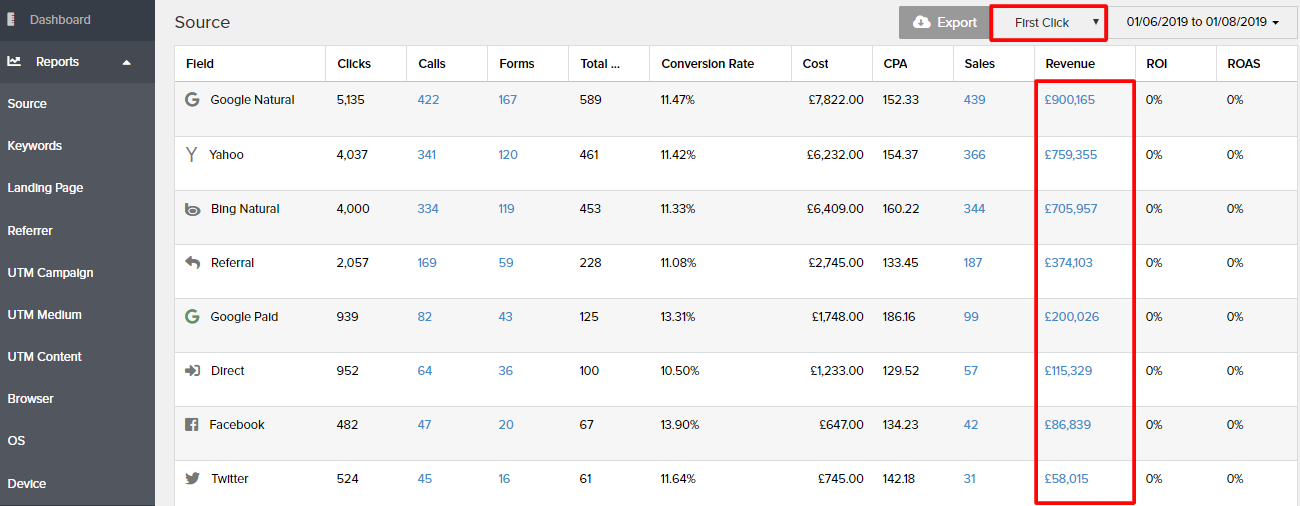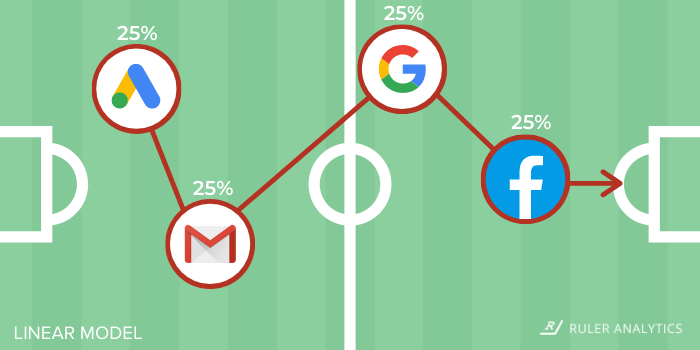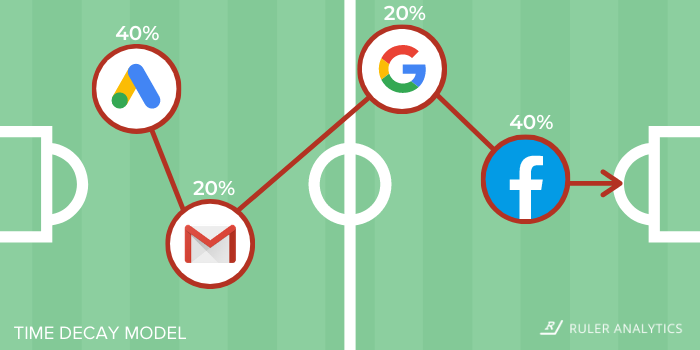What is an attribution model? Why are attribution models important? How do I get started with attribution modelling? These are questions we get all the time. So we created this simple guide to highlight the answers.
In an ideal world, we would want our visitors to click on one of our ads or blog posts and convert into a lead almost instantly.
How easy would it be to demonstrate the value of our marketing?
We could simply sign into Google Analytics and assign a value to a goal using last-click attribution.
The pressure of having to prove the ROI of our marketing activities would simply disappear.
Sadly, life isn’t that simple.
Visitors don’t just land on your website and make a sale. According to Think with Google, users could have as many as 20 touchpoints with your content before they make a sale.
Of course, average touchpoints are dependent on the value of the sale and industry type.
But, whatever service or product you’re selling, it’s extremely likely that your customers generated several touchpoints before converting into revenue.
So, on that note, we’re going to explore attribution modelling in more detail looking at how each one works and how to find the best fit for you to measure your marketing.
For this article, we’ll discuss:
Without further ado, let’s get started.
💡 Pro Tip
Have you heard about our free attribution e-learning platform? Learn about marketing attribution at your own pace—any time, anywhere. Perfect for marketers at all levels.
Sign up for attribution academy (it’s free)
Attribution modelling is one of the most talked-about topics in digital marketing and probably the least understood.
Put simply, attribution modelling is a set of rules that determines how your analytics tool applies credit for clicks, conversions and sales.
Attribution modelling allows marketers to take a holistic view of their advertising efforts and evaluate which keywords, ads and landing pages drive the most value.
Understanding attribution models is critical to measuring campaign performance.
With the right attribution model, you can find out exactly what impact your marketing is having on your bottom-line activity.
The following attribution models are what you will see in most ad and analytics platforms (we will examine these in more detail throughout this guide on attribution modelling):
💡 Pro Tip
Most companies will use marketing attribution software to look through the lens of each attribution model and assign value to any factor that may have contributed to the success of a sale. You can find more out in our blog on marketing attribution software and tools.
Wherever your strengths lie in the marketing world, if you don’t spend time educating yourself and finding the appropriate attribution model for your goals, your campaigns will eventually start to plateau.
They’re crucial to understanding how your campaigns are performing and how much revenue your efforts are generating for your business.
There are some great benefits to looking more closely at marketing attribution, such as:
As we’ve already discussed, users could have as many as 20 touchpoints before converting into a sale.
Attribution modelling offers a more accurate understanding of how various touchpoints in the customers’ journey work together to deliver leads and conversions.
💡 Pro Tip
Would you like full visibility of the customer journey from brand awareness to conversion? In our guide on tracking customer journeys, you’ll learn how to unlock valuable data across the entire buying cycle and identify your most profitable campaigns.
Download the guide on tracking customer touchpoint
If you don’t understand how credit is applied to all of your campaigns, it’s impossible to use your analytics system to determine which campaigns are performing the best.
Vanity metrics like clicks, traffic, and time on site are all good metrics to measure, but if your end goal is generating revenue, you need to know which campaigns do the best job of driving sales.
Related: How to track your sales leads and increase marketing revenue
Attribution modelling provides marketers with more insight into the marketing touchpoints that play the most significant role in the customer journey and can ensure budgets are allocated more effectively.
Attribution modelling gives you more control to identify the most successful marketing touchpoints, allowing you to create detailed reports which you can share with company executives and clients.
Related: A complete guide to tracking marketing touchpoints
You will be able to devise optimised marketing campaigns with justified budgets, removing any speculation and guesswork.
While we’re on the subject, we have a guide on how to measure your marketing effectiveness with attribution, which may come in handy.
Company executives expect marketing teams to be able to prove ROI.
Related: How to measure digital marketing ROI with Ruler
If you’re not tracking your campaigns properly, you won’t be able to tell them the ROI of your efforts.
Imagine for a moment that you’re in charge of marketing for an e-Commerce site.
You run a series of ads on Google, and over 100 people click and make a purchase.
In that situation, it’s pretty obvious that the source of those sales was your ad campaign.
But, in B2B marketing, it’s rarely so simple.
Most B2B buyers aren’t just following an ad and making the purchase there and then.
Maybe they follow an ad the first time and check out your site.
They may decide to read a few of your blog posts and sign up for your newsletter.
Over the next few months, they download case studies sent in your newsletter and follow your brand on social.
Ultimately they make a purchase.
But what campaign do you attribute revenue to? Is it the original ad they clicked on, your blog, email campaigns, case studies, or all four?
If you don’t know which attribution model your analytics program is using, then your metrics may be deceiving.
It’s possible that it’s attributing all of the revenue to ads, which masks the fact that your content, email, and social media marketing campaigns all played a part in the sale.
💡 Pro Tip
Closed-loop marketing attribution can reveal which of your marketing sources are generating the most revenue. Download the closed-loop marketing attribution eBook to find out more.
To really know which of your campaigns is performing the best and generating the most leads and revenue, you must understand the different types of attribution models, and make sure your analytics tool is using the one that makes the most sense for how you run your campaigns.
To explain the most common marketing attribution models, it helps to refer to an example buyer’s journey, as shown below:

1. An anonymous visitor clicks on a Google Ad and downloads an eBook from your website.
2. The lead goes through an email cadence, clicks a link and returns to your site to learn more about your services.
3. Two weeks later, they visit your website using a brand search via Google organic.
4. Shortly after they click on a retargeting ad on Facebook and convert by scheduling a meeting with your sales team.
In the first-click attribution model, all of the credit generated from the sale is attributed to the very first channel or campaign that the customer interacted with.
Related: What is the first-click attribution model? A complete guide

In the visitor journey above, first-click would attribute all of the revenue from the sale to the ad the customer first clicked on.
First-click attribution is good at showing you which of your campaigns generate the most awareness and traffic.
The screenshot below is how you would assign first-click revenue automatically if you were using marketing attribution analytics such as Ruler:

First-click attribution, however, doesn’t take into account all of the other touchpoints a customer interacted with along their journey.
It certainly wasn’t just the ad that drove the sale; the blog and email marketing campaign also played a part in getting the user back on the site.
In the last click attribution model, all of the credit is attributed to the very last channel the customer interacted with before making a conversion.
Related: Marketers guide to last-click attribution

In the example above, last-click attribution would assign the revenue to the retargeting ad on Facebook.
Last click attribution can show you what the final point is in your buying journey and what channels are most effective at turning anonymous visitors into leads or sales.
In the screenshot below, we’ve used the same account and date range that appeared in the first-click example, but assigned it to last-click:

Like first-click attribution, this model neglects all of the other marketing touchpoints that played a part in influencing a conversion and essentially doesn’t account for any of the other campaigns or channels the customer interacted with.
There is one small difference between last non-direct click attribution and last-click attribution.
Direct traffic is ignored, and 100% of the credit is assigned to the last channel that the visitor engaged with before making a conversion.
To explain this attribution model, we’ll need to change our customer journey slightly.

If we were to look at our customer journey, 100% of the credit would be assigned to the organic search.
This model is best if you want to fully understand the effectiveness of your final marketing activities without direct traffic getting in the way of your analysis.
However, this model still doesn’t account for any of the other campaigns or channels the customer interacted with.
In the linear attribution model, credit from the conversion is distributed evenly across all of the touchpoints in the buyer’s journey.

In the example above, the customer interacted with four different marketing channels. The linear attribution model would divide the credit generated by four, attributing 25% of the sale to each of those touchpoints.
Unlike first-click and last-click, linear attribution makes sure every campaign and channel that plays a part in the journey gets equal credit for the conversion. That said, marketers don’t often implement this model for one reason.
When all the channels receive equal credit, how can you possibly tell which channels are contributing the most value to the conversion path?
Remember, the whole point of using attribution modelling is to know what channel or campaigns provide the most significance.
In the time decay attribution model, credit from the conversion is distributed to all marketing touchpoints, but the later touchpoints receive a higher percentage of credit than the earlier ones.

In the example above, the customer used four touchpoints. The time decay attribution model would give credit to all four touchpoints, but the last two—Google Ads and Facebook—would receive a higher percentage of credit than the first two touchpoints.
Time decay is good for showing you two things.
Like linear attribution, it shows you all of the campaigns and channels that played a part in generating the conversion.
Secondly, it shows you which of your campaigns and channels do the best job of getting leads to convert into an opportunity.
This is useful, but if you’re primarily focusing on top-of-the-funnel (TOFU) performance, then this wouldn’t be the best attribution model for you.
Time decay attribution doesn’t apply a fair amount of credit to any campaigns at the top-of-the-funnel as it’s typically the farthest away from the conversion point.
Referred to as position-based by Google, U-shaped attribution is a multi-touch option that will prioritise the first anonymous touchpoint that initiated the visitor and the lead conversion touchpoint.
The U-Shaped attribution model tracks every single touchpoint but will assign 40% to first and last-click.
The remaining 20% is then split evenly among the other touchpoints.

So, in the example above, 40% would be assigned to Google Ads and Facebook.
Then, the remaining 20% would be split across the organic search and email.
The U-Shaped attribution model is great for telling you two things:
Also, position-based assigns a portion of the credit to each touchpoint in the journey whilst allowing you to optimise for the first and last-click attribution.
Some may believe that this is the perfect attribution model when it comes to measuring marketing performance.
However, like every other attribution model mentioned, position-based comes with its limitations.
Position-based treats all of the touchpoints in the middle as equal. In reality, however, some marketing channels may contribute to the journey more than others.
For example, if we refer back to our customer journey, Google organic inspired a brand search.
Without this, there’s a chance that the visitor would never have received the retargeting ad on Facebook. Despite this, Google organic received less credit than Facebook
Like, U-shaped attribution, W-shaped attribution assigns more credit to the first and last touchpoints in a buyer’s journey.
However, it also assigns heavier value to the the mid-funnel touchpoint where a consumer can be actively considered a lead. The remaining credit is split evenly between any remaining touchpoints.
So, if we revert back to our example above, the Google ad, Google organic and Facebook would all receive 30% credit. The remaining 10% would be then assigned to email.
The W-shaped model is a popular hit with B2B marketers, especially those operating a sophisticated marketing funnel and have a huge focus on lead generation campaigns.
It allows them to identify how their audience found them, where they made their initial contact and how they converted into a prospective lead without spending too much focus on the points in between.
Despite being around for some time now, marketers still find the process of attribution modelling a challenge.
And, as more attribution models are created, it becomes more difficult to pick the right one for your business.
There is no such thing as the best attribution model that fits all advertisers needs, however, here are some tips to help you get started.
Before using any attribution model, ensure you have acquired a deep understanding of your industry and target market. If you don’t, then you could end up applying a wrong attribution model, and as a result, lose out on qualified leads and sales.
The attribution models you choose should help you confront the most complex questions commonly asked by company executives and clients, such as;
The right marketing attribution tools can offer complete visibility of every touchpoint along the customer journey, allowing marketing teams to make educated, data-driven decisions for future campaigns.
Attribution modelling is not a matter of set and forget, but more test, set, analyse and repeat. Naturally, your campaigns, ads and objectives will continue to evolve, and so will the need to update your attribution modelling.
Constantly testing and refining your attribution modelling will allow you to deliver the most accurate and sophisticated results and ensure that you’re focused on the right campaigns.
When it comes to the attribution model, there is not a one-size-fits-all solution.
The attribution model you choose will depend on the channels and campaigns you are analysing.
You’ll need a model that is connected to your specific goals.
There’s a chance that you might not get it right the first time around–but that’s ok.
Our analytics solution, Ruler Analytics, makes it easy for marketers to track marketing-generated revenue and attribute that revenue to the right campaigns whether it be first or last-click attribution.
Marketers have been using our product to switch between multiple different models, first-click, last-click, or linear, to see how their individual campaigns perform in different scenarios.
In addition to this, they have customer journey mapping to get a complete list of every single interaction that took place before the conversion.
If you want to see the closed-loop marketing attribution model in action, then book a demo today.
Our experts will run you through how the platform works, and how you can use it to prove your marketing ROI and optimise your marketing efforts.

This article was originally published on 9th May 2018 and was last updated on 14th January 2022.